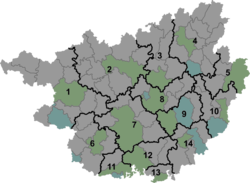Bobai County
Bobai (Chinese: 博白; pinyin: Bóbái; Zhuang: Bozbwz) is a county of Guangxi, China. It is under the administration of Yulin city.
Bobai County 博白县 · Bozbwz Yen Pokpak | |
|---|---|
County | |
 Bobai Location of the seat in Guangxi | |
| Coordinates: 22.2758°N 109.972°E | |
| Country | People's Republic of China |
| Autonomous region | Guangxi |
| Prefecture-level city | Yulin |
| Area | |
| • Total | 3,836 km2 (1,481 sq mi) |
| Time zone | UTC+8 (China Standard) |
Bobai was the home town of the linguist Wang Li, who described the Bobai dialect with its unusually large number of tones.
Transportation
The county is served by the Yulin–Tieshangang Railway. The railway opened for freight service in May 2015. Passenger service to the new Bobai Station will start on April 1, 2016.[1]
Contestation and protests
In May 2007, Bobai was the site of large protests held by local people against China's one-child policy,[2] and triggered the protest in Yangmei, Rongxian.
The small office of a grassroots NGO for sex workers' rights was ransacked and its leader Ye Haiyan was also attacked.[3]
Climate
| Climate data for Bobai (1981−2010) | |||||||||||||
|---|---|---|---|---|---|---|---|---|---|---|---|---|---|
| Month | Jan | Feb | Mar | Apr | May | Jun | Jul | Aug | Sep | Oct | Nov | Dec | Year |
| Record high °C (°F) | 28.5 (83.3) |
31.4 (88.5) |
33.6 (92.5) |
34.8 (94.6) |
35.9 (96.6) |
36.9 (98.4) |
38.9 (102.0) |
37.6 (99.7) |
36.6 (97.9) |
35.0 (95.0) |
33.1 (91.6) |
29.8 (85.6) |
38.9 (102.0) |
| Average high °C (°F) | 18.3 (64.9) |
19.2 (66.6) |
22.1 (71.8) |
26.8 (80.2) |
30.4 (86.7) |
32.0 (89.6) |
32.8 (91.0) |
32.9 (91.2) |
31.8 (89.2) |
29.3 (84.7) |
25.2 (77.4) |
21.1 (70.0) |
26.8 (80.3) |
| Daily mean °C (°F) | 14.0 (57.2) |
15.4 (59.7) |
18.4 (65.1) |
23.0 (73.4) |
26.1 (79.0) |
27.7 (81.9) |
28.3 (82.9) |
28.2 (82.8) |
27.0 (80.6) |
24.4 (75.9) |
20.0 (68.0) |
15.8 (60.4) |
22.4 (72.2) |
| Average low °C (°F) | 11.1 (52.0) |
12.8 (55.0) |
15.8 (60.4) |
20.4 (68.7) |
23.3 (73.9) |
25.0 (77.0) |
25.4 (77.7) |
25.3 (77.5) |
23.9 (75.0) |
20.9 (69.6) |
16.4 (61.5) |
12.3 (54.1) |
19.4 (66.9) |
| Record low °C (°F) | 2.3 (36.1) |
2.3 (36.1) |
3.3 (37.9) |
9.0 (48.2) |
15.0 (59.0) |
18.5 (65.3) |
20.6 (69.1) |
21.5 (70.7) |
15.7 (60.3) |
10.1 (50.2) |
4.8 (40.6) |
2.1 (35.8) |
2.1 (35.8) |
| Average precipitation mm (inches) | 51.0 (2.01) |
69.0 (2.72) |
81.8 (3.22) |
168.5 (6.63) |
249.4 (9.82) |
274.3 (10.80) |
333.2 (13.12) |
260.9 (10.27) |
174.8 (6.88) |
64.7 (2.55) |
39.4 (1.55) |
29.7 (1.17) |
1,796.7 (70.74) |
| Average relative humidity (%) | 76 | 81 | 83 | 83 | 82 | 84 | 82 | 83 | 79 | 74 | 70 | 69 | 79 |
| Source: China Meteorological Data Service Center | |||||||||||||
gollark: Which means accurately made lenses and stuff too, I guess?
gollark: I also had the idea of Discworld-style semaphore-tower networks driven by magical systems instead of human operators, but that would probably also be too complex to implement.
gollark: I see. It's kind of hard trying to figure out what sort of modern stuff would work in a world where most of the stuff we kind of assume exists doesn't.
gollark: I was reading the telegraph thing, and wondering if they could practically do radio, or if that would need too much power or electronics knowledge/capability.
gollark: Maybe they need Morey *and* Cato?
References
This article is issued from Wikipedia. The text is licensed under Creative Commons - Attribution - Sharealike. Additional terms may apply for the media files.